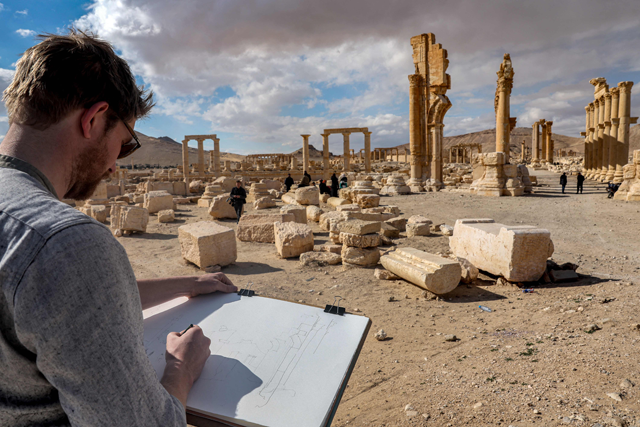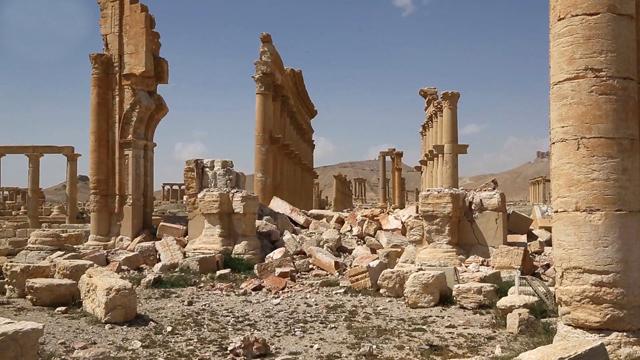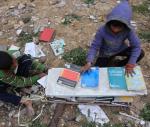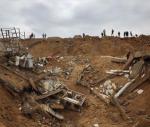You are here
Syrians back to famed Palmyra ruins scarred by Daesh
By AFP - Feb 10,2025 - Last updated at Feb 10,2025

A visitor sketches while seated before the Great Colonnade (Decumanus Maximus) at the ancient ruins of Palmyra in central Syria on February 7, 2025 (AFP Photo)
PALMYRA, Syria — Syrians are once again picnicking and smoking shisha amid the ruins of ancient Palmyra, once desecrated by extremists but still awe-inspiring, and open to the public following the overthrow of president Bashar Al Assad.
The city's renowned ruins, a UNESCO World Heritage Site, were twice overrun by the Daesh terror group, which proceeded to destroy many of the most famed structures.
Although they were driven out, the Syrian government and its allies, including Russia and Iran, then set up military bases nearby, effectively barring public access.
Open to the public once more, Yasser Al Mahmoud, 54, was among dozens of formerly displaced Syrians rediscovering the beloved landmarks that still bear scars of war.
"We used to come here every Friday, before" the war, Mahmoud said, pouring hot tea into glass cups placed atop a massive column's stone base.
"Now we're back and we can reconnect with our memories," he said, standing near his wife and children.
"People are so happy," he said.
Spread out across the ruins, families were carrying bags of food and making tea, while young people smoked shisha.
"We really missed the ruins. We haven't been here since 2015," when Daesh first invaded the area before being forced out for good in 2017.
Mahmoud said he wanted to reopen his stall selling trinkets and jewellery once visitors returned to Palmyra -- which attracted more than 150,000 tourists a year before civil war broke out in 2011.
Nearby, two huge columns forming a squared arch stood amid a sea of rubble -- all that remained of the Temple of Bel after Daesh extremists detonated explosives inside it.
Illegal excavations
Known to Syrians as the "Pearl of the Desert", Palmyra was home to some of the best-preserved classical monuments in the Middle East before Syria's 13-year war.
But IS launched a campaign of destruction after capturing Palmyra, using its ancient theatre as a venue for public executions and murdering its 82-year-old former antiquities chief.
The extremists blew up the shrine of Baal Shamin, destroyed the Temple of Bel, dynamited the Arch of Triumph, looted the museum and defaced statues and sarcophagi.
While the jihadists are gone, danger still looms over Palmyra.
The director general of antiquities and museums in Syria, Nazir Awad, told AFP he was concerned about illegal excavation.
There are guards, he said, "but I don't think they can do their work to the fullest extent, because of random and barbaric excavations across very wide areas".
People looking for ancient artefacts to loot are using heavy machinery and metal detectors that are "destructive", adding that the digging was "destroying layers of archaeological sites, leaving nothing behind".
'A military zone'
The Syrian Observatory for Human Rights war monitor said Assad's allies established "military sites and positions" in Palmyra and its archaeological sites, even taking up residence in its hotels.
In a sign of their presence, Israeli air strikes in November on the modern city killed 106 Tehran-backed fighters, according to the British-based monitor with a network of sources in Syria.
Former rebel fighter Khaldun Al Rubaa, 32, said Palmyra had been turned "from an archaeological site into a military zone" that was off-limits to visitors.
He worked at Palmyra's ancient sites from childhood, giving tourists camel rides and, like many Palmyra residents, tourism was his main source of income, he said.
Now that Assad-allied armed groups and foreign armies have left, Rubaa has returned home, hoping to trade his arms for a camel.
He held a picture on his phone of him as a young boy riding his camel, killed in the fighting, with the Arch of Triumph in the background.
"Palmyra and the ruins have been through horrors. The site has seen Daesh, Iran, the Russians, all of the militias you could think of," he said.
Yet he is among the lucky ones able to settle back home.
After 12 years of displacement Khaled Al Sheleel, 57, said he has yet to return to his house, destroyed in an Israeli strike.
He now works as a taxi driver, mostly carrying residents wishing to visit or return home.
"We have no homes, we cannot return," he said.
But "despite the destruction, I was overjoyed, I knelt on the ground and cried tears of joy when I returned" for the first time.
Related Articles
DAMASCUS — Palmyra's renowned Temple of Bel, blown up by the Daesh terror group last year, is not beyond repair but the full extent of
PALMYRA, Syria — Syrian troops recaptured the ancient city of Palmyra from the Daesh terror group on Sunday and pledged to build on the win
Beirut — The Daesh terror group executed three people in Syria's ancient city of Palmyra by binding them to three historic columns and blowi

















